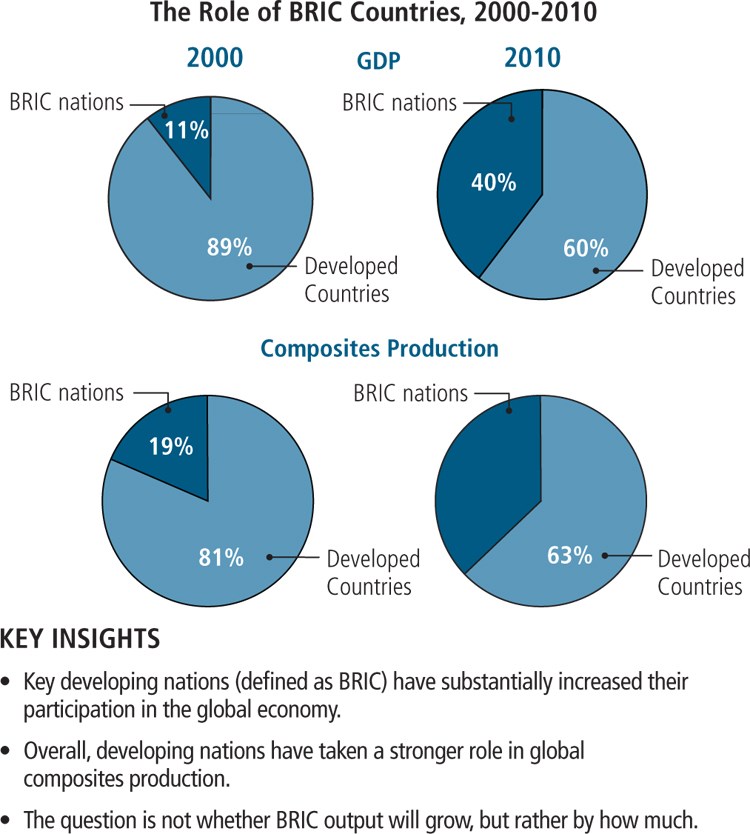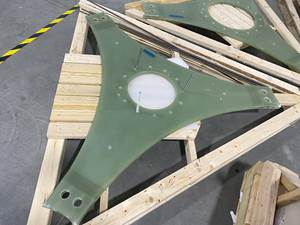Growth opportunites in global composites: 2016 and beyond
Lucintel LLC's (Irving, Texas) VP of consulting Norm Timmins predicts where and how much the global composites industry will grow during the next five years.
The global composite materials industry reached a total value of $17.7 billion (USD) in 2010 and, despite a still-sluggish world economy, its growth rate was 10.3 percent. Let’s break the numbers down a bit: Of the composite materials market’s global revenue, resins accounted for $8.8 billion and fibers accounted for $7.7 billion, with ancillary materials making up the difference. The total value of composite end products reached $50.2 billion. By 2016, I predict that the composite materials industry will reach $27.4 billion — a 7.8 percent compound annual growth rate (CAGR). In the same timeframe, composite end-products will total $78 billion.
What are some of the factors that have influenced this prediction? To evaluate the market opportunities for composite materials, Lucintel first looks at the penetration of composites into various market segments. In transportation, composites have a 3.6 percent share, based on monetary value, compared to a 68 percent share in marine. In construction, composites occupy 7 percent of the market; in aerospace, 10 percent; and in wind energy, 38 percent. These figures plainly indicate that there is vast growth potential for composites. The industry is certainly sustainable: In our view, there are upwards of 30,000 potential product applications. It is true that a variety of market segments have experienced huge fluctuations during the past five years, relative to the gross domestic product (GDP), and that composites performed poorly in the last half-decade. Yet, composites industry growth outpaced GDP in 2010, and trend data suggest that it will grow faster than GDP during the next five years.
Secondly, we look at the potential for growth geographically. Here, developing countries will foster strong growth as they begin to play larger roles in the global economy and in composites manufacturing. These emerging economies include Brazil, Russia, India and China (the so-called BRIC nations), which are experiencing rapid growth and urbanization and show evidence of emerging middle classes and increased OEM production. In reference to BRIC composites production, it is not whether it will grow, but rather by how much. BRIC economic growth likely will lead to greater market fragmentation as composites-related companies jockey for space and share, but those with the capacity for innovation will thrive.
Another potent growth driver will be China’s wind market. Lucintel predicts that it will grow a robust 23 percent or more per year through 2015, based on our belief that wind is expected to remain the dominant renewable energy source during the next 10 years. The Chinese government has committed to generate at least 15 percent of its energy by means other than burning fossil fuels by 2020 — the country is currently at 8.5 percent. In pursuit of that goal, China will face major challenges. It lacks grid capacity, and 30 percent of its existing wind turbines are not connected to its national grid.
Although the U.S. wind market fell in 2010, there is still considerable growth potential, despite competition from natural gas and our own grid-connectivity problems. The lack of robust, long-term federal targets for renewables is unfortunate, but political support for renewable energy is expected, going forward. And even in highly developed wind markets, such as Germany, the penetration of composites compared to the potential remains low, at only 30 percent.
In our view, the future is bright. Although emerging countries will forge a new reality as they enter the composites fray, and the increased competition will mean fast-changing and complex markets, global composite materials growth of 5.9 percent in 2011 appears very likely. The sluggish automotive, construction, electronics and consumer-goods markets should bounce back. In North America and Europe, watch for wind and aerospace to remain the most attractive growth markets. Population increases, infrastructure needs and the green movement are only a few of the factors that will drive composites growth to new horizons. In the end, innovations that reduce the cost of composite products by 30 percent have the potential to triple the composites market.
Editor’s note: This article is excerpted from Timmins’ recent keynote address at the ACMA COMPOSITES 2011 Show in Ft. Lauderdale, Fla.
Related Content
Novel composite technology replaces welded joints in tubular structures
The Tree Composites TC-joint replaces traditional welding in jacket foundations for offshore wind turbine generator applications, advancing the world’s quest for fast, sustainable energy deployment.
Read MoreRTM, dry braided fabric enable faster, cost-effective manufacture for hydrokinetic turbine components
Switching from prepreg to RTM led to significant time and cost savings for the manufacture of fiberglass struts and complex carbon fiber composite foils that power ORPC’s RivGen systems.
Read MoreMingYang reveals 18-MW offshore wind turbine model with 140-meter-long blades
The Chinese wind turbine manufacturer surpasses its 16-MW platform, optimizes wind farm construction costs for 1-GW wind farms.
Read MoreAchieving composites innovation through collaboration
Stephen Heinz, vice president of R&I for Syensqo delivered an inspirational keynote at SAMPE 2024, highlighting the significant role of composite materials in emerging technologies and encouraging broader collaboration within the manufacturing community.
Read MoreRead Next
All-recycled, needle-punched nonwoven CFRP slashes carbon footprint of Formula 2 seat
Dallara and Tenowo collaborate to produce a race-ready Formula 2 seat using recycled carbon fiber, reducing CO2 emissions by 97.5% compared to virgin materials.
Read MoreDeveloping bonded composite repair for ships, offshore units
Bureau Veritas and industry partners issue guidelines and pave the way for certification via StrengthBond Offshore project.
Read MorePlant tour: Daher Shap’in TechCenter and composites production plant, Saint-Aignan-de-Grandlieu, France
Co-located R&D and production advance OOA thermosets, thermoplastics, welding, recycling and digital technologies for faster processing and certification of lighter, more sustainable composites.
Read More














.jpg;maxWidth=300;quality=90)








